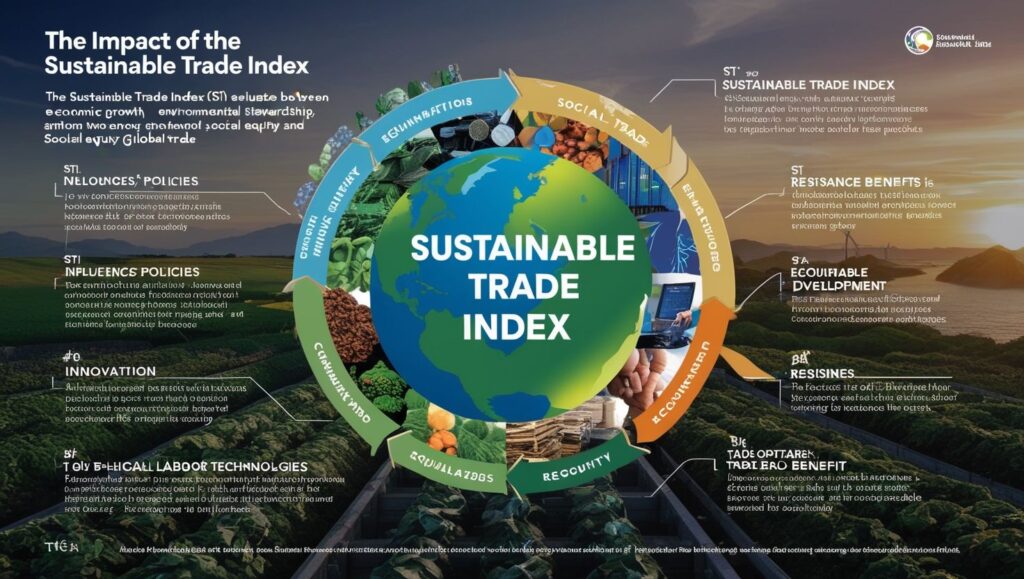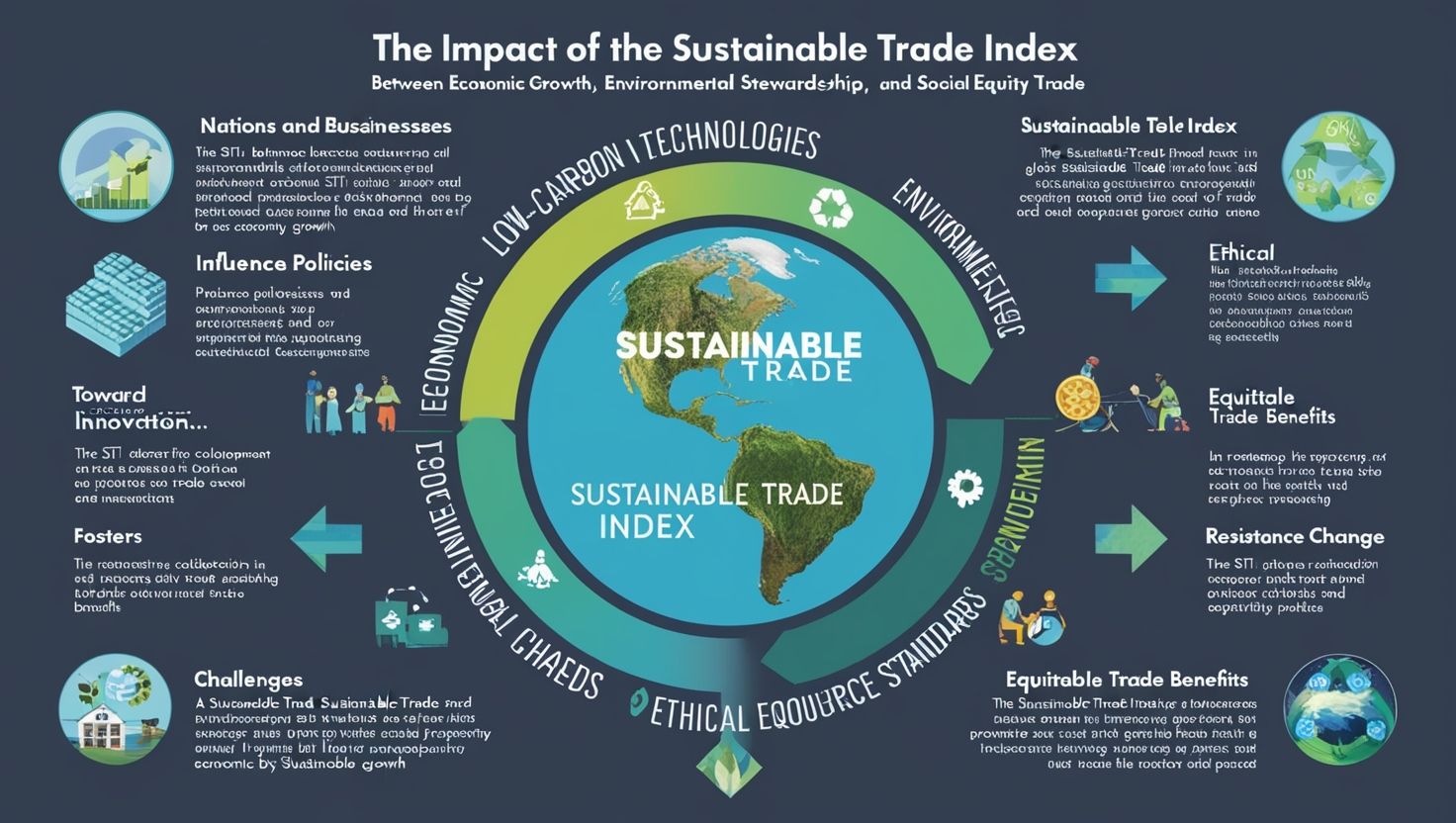Introduction
The Impact of the Sustainable Trade Index, Trade has long been a critical component of global economic growth and development. However, as environmental and social concerns rise, the concept of sustainability has gained traction in global trade practices. The Sustainable Trade Index (STI) emerges as a pivotal metric, evaluating trade practices that balance economic growth, environmental responsibility, and social equity. By providing a framework for sustainable commerce, the STI helps governments, businesses, and civil society organizations measure and improve trade practices. Its impact extends beyond economics, influencing policy, corporate strategy, and international relations.
Understanding the Sustainable Trade Index
The Sustainable Trade Index is a tool that measures the sustainability of trade practices across countries. It evaluates trade’s impact on three dimensions:
- Economic Pillar: Measures trade’s role in promoting economic growth, innovation, and infrastructure development.
- Environmental Pillar: Focuses on carbon footprints, biodiversity conservation, and the sustainable use of resources in trade activities.
- Social Pillar: Assesses labor rights, community welfare, and equitable access to trade benefits.
Developed by organizations such as the Economist Intelligence Unit and supported by regional partnerships, the STI ranks countries based on their adherence to these principles, enabling comparisons and fostering global dialogue on sustainable trade.
Economic Impact
The STI promotes economic resilience by encouraging long-term strategies rather than short-term profit-driven trade practices. Here’s how it influences economies:
- Enhancing Market Competitiveness: Countries with strong STI performance are seen as reliable and sustainable trading partners. This perception attracts foreign investment and builds market confidence. For example, Scandinavian countries, with their high sustainability rankings, enjoy robust trade partnerships.
- Fostering Innovation: The index incentivizes innovation in sustainable technologies, such as renewable energy and green supply chains. Countries competing for higher rankings invest in research and development, fostering innovation ecosystems.
- Boosting Resilience: Economic resilience grows as countries diversify trade portfolios and reduce dependence on non-renewable resources. A sustainable approach mitigates risks associated with climate change and resource depletion.
Environmental Impact
The STI significantly impacts environmental stewardship in global trade. Its emphasis on sustainable practices has led to notable improvements:
- Reducing Carbon Footprints: Nations prioritize low-carbon technologies and eco-friendly transportation systems to align with STI benchmarks. For instance, Japan and Germany have adopted green logistics, reducing emissions in international trade.
- Promoting Renewable Energy: The STI encourages the adoption of renewable energy sources in industrial production and exports. Solar and wind-powered manufacturing hubs are gaining prominence globally.
- Encouraging Resource Conservation: By highlighting resource sustainability, the index pushes countries to implement circular economies, reducing waste and enhancing resource efficiency.
Social Impact
The social dimension of the STI addresses labor standards, equity, and inclusivity, driving significant societal benefits:
- Improving Labor Standards: The STI promotes ethical labor practices, urging countries to comply with international labor laws. As a result, working conditions in developing economies have improved.
- Empowering Marginalized Communities: Sustainable trade policies aim to include small-scale producers, women, and underrepresented groups in trade activities. This inclusivity fosters social equity and reduces economic disparities.
- Promoting Consumer Awareness: Consumers are increasingly demanding sustainably sourced products. The STI encourages businesses to adopt fair trade practices and transparent supply chains, aligning with consumer expectations.
Influence on Policy and Governance
The STI drives policy reforms and governance improvements, reshaping trade landscapes worldwide:
- Policy Formulation: Governments use STI metrics to design policies that align trade practices with sustainable development goals (SDGs). For instance, the European Union’s Green Deal incorporates STI principles to achieve carbon neutrality by 2050.
- Trade Agreements: Bilateral and multilateral trade agreements now include sustainability clauses influenced by STI benchmarks. These clauses ensure environmental and social safeguards in international trade.
- Global Collaboration: The STI fosters partnerships among nations to address shared challenges, such as climate change and resource management. Collaborative efforts like the Paris Agreement are strengthened by the index’s principles.

Corporate Strategy and Adaptation
Businesses worldwide are adapting to the STI’s expectations, transforming corporate strategies:
- Sustainable Supply Chains: Companies are redesigning supply chains to minimize environmental and social impacts. Initiatives like carbon labeling and ethical sourcing have gained momentum.
- Corporate Social Responsibility (CSR): Businesses are integrating STI-aligned CSR initiatives, enhancing brand reputation and customer loyalty.
- Risk Management: The STI helps corporations identify and mitigate risks related to unsustainable practices, such as resource scarcity and regulatory penalties.
Challenges in Implementing STI Principles
Despite its benefits, the STI faces several challenges:
- Measurement Limitations: Accurately quantifying sustainability in diverse economies remains complex. Differences in data availability and quality hinder comprehensive analysis.
- Resistance from Stakeholders: Transitioning to sustainable practices can face resistance from industries reliant on traditional methods. Balancing economic growth with sustainability requires robust stakeholder engagement.
- Geopolitical Dynamics: Unequal access to resources and technology among nations creates disparities in STI rankings. Developing countries may struggle to meet STI benchmarks without international support.
Future Prospects of the STI
The STI’s future lies in continuous refinement and broader adoption:
- Digital Integration: Leveraging artificial intelligence and big data can enhance STI assessments, providing real-time insights into trade sustainability.
- Regional Customization: Tailoring STI metrics to regional contexts can address specific challenges, promoting inclusive growth.
- Incentivizing Participation: International organizations can offer incentives, such as funding and technical support, to encourage countries to adopt STI-aligned practices.
Conclusion
The Sustainable Trade Index is a transformative tool that bridges economic growth, environmental responsibility, and social equity. Its impact is far-reaching, influencing policy-making, corporate strategies, and consumer behavior. By promoting transparency and accountability, the STI fosters a global commitment to sustainable development. As the world faces pressing challenges like climate change and inequality, the STI provides a roadmap for achieving sustainable and inclusive trade practices, ensuring long-term prosperity for all stakeholders.

9i0do5
Please let me know if you’re looking for a article author for your site. You have some really great posts and I feel I would be a good asset. If you ever want to take some of the load off, I’d love to write some articles for your blog in exchange for a link back to mine. Please send me an email if interested. Kudos!
q7lzf0
Looking for the best alarm clock radio with CD player and modern features? This HD tabletop radio combines vintage charm with today’s technology. Features include a CD player, AM/FM radio, dual alarm settings, and a USB port for device charging. Perfect for bedside tables or desktops, the sleek design doesn’t sacrifice performance. Whether you’re waking up to your favorite radio station, a beloved CD, or a gentle buzzer, this unit is your all-in-one morning companion. The CD clock radio is back—and better than ever.
It?¦s actually a great and useful piece of info. I?¦m satisfied that you simply shared this useful info with us. Please stay us informed like this. Thank you for sharing.
hello!,I love your writing so much! percentage we keep up a correspondence more approximately your post on AOL? I require a specialist in this space to unravel my problem. May be that’s you! Looking forward to look you.
Do you have a spam problem on this site; I also am a blogger, and I was curious about your situation; many of us have developed some nice practices and we are looking to trade strategies with other folks, be sure to shoot me an email if interested.
Keep functioning ,great job!
Nice post. I learn something more challenging on different blogs everyday. It will always be stimulating to read content from other writers and practice a little something from their store. I’d prefer to use some with the content on my blog whether you don’t mind. Natually I’ll give you a link on your web blog. Thanks for sharing.
Nice post. I learn something more challenging on different blogs everyday. It will always be stimulating to read content from other writers and practice a little something from their store. I’d prefer to use some with the content on my blog whether you don’t mind. Natually I’ll give you a link on your web blog. Thanks for sharing.
Please let me know if you’re looking for a article author for your weblog. You have some really great articles and I believe I would be a good asset. If you ever want to take some of the load off, I’d really like to write some material for your blog in exchange for a link back to mine. Please blast me an e-mail if interested. Thanks!
I feel this is among the such a lot vital info for me. And i am glad reading your article. But should observation on few normal things, The web site taste is wonderful, the articles is in reality great : D. Excellent activity, cheers